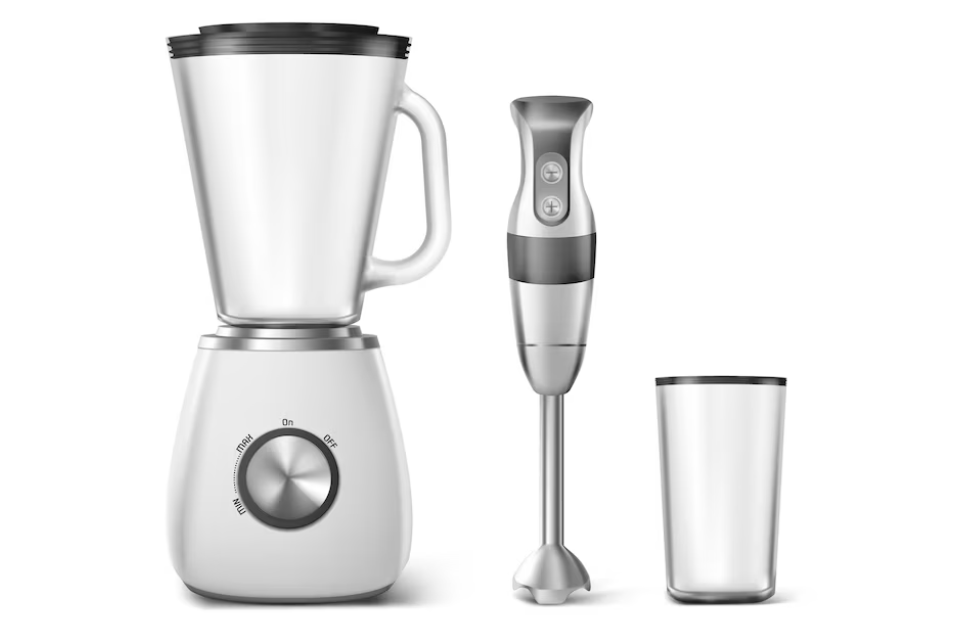Differences Between Juicers and Blenders
Functionality:
Blenders serve a multitude of purposes, including blending, pureeing, and emulsifying substances. They’re perfect for preparing soups, dips, sauces, smoothies, and even crushing ice. Blenders retain the pulp and fiber, resulting in a more substantial beverage. Conversely, juicers are tailored specifically to extract juice from fruits and vegetables, leaving behind a clean, pulp-free liquid for those who prefer their juice that way.
Output:
Blenders yield a thicker, more textured drink due to the incorporation of all ingredients, including pulp and fiber. This can be advantageous for those who prefer a more satisfying beverage with retained fiber and nutrients. Juicers, on the other hand, produce a clear, smooth juice with minimal or no pulp, ideal for those seeking a refined, pulp-free beverage experience.
Nutritional Value:
Blended beverages retain fruit and vegetable pulp and fiber, offering a more satiating and nutrient-dense drink. The fiber aids in prolonged satiety and digestion control, while blending releases more nutrients from the fruits. Conversely, juicers remove pulp and fiber, resulting in a juice with less fiber content. Although juiced drinks still contain vital nutrients, blended drinks may offer greater satisfaction.
Ease of Use and Cleaning:
Blenders are generally easier to use and clean, with straightforward controls and easy-to-rinse components. Conversely, juicers require more effort to assemble and clean, often consisting of multiple parts that need to be disassembled for cleaning. Cleaning a juicer can be time-consuming due to the need to clean each juice-producing component thoroughly.
Cost:
Blenders are typically more affordable than juicers, making them accessible to a wider range of consumers. Juicers, especially high-quality ones, tend to be pricier. Therefore, cost may be a factor to consider when choosing between a blender and a juicer based on individual preferences and budget constraints.

Table of Differences between Juicer and Blender
| Characteristic | Juicer | Blender |
|---|---|---|
| Function | Extracts juice from fruits and veggies | Blends ingredients into a smooth mixture |
| Output | Produces juice | Produces smoothies, shakes, and purees |
| Texture | Liquid | Variable (smooth or chunky) |
| Fiber Content | Low | Retains fiber from ingredients |
| Nutrient Retention | May reduce some nutrients due to extraction process | Retains most nutrients from ingredients |
| Cleaning | Typically more involved due to multiple parts | Easier cleanup with fewer components |
| Types | Centrifugal, masticating, triturating | Countertop, immersion, personal |
| Uses | Primarily for juicing | Versatile; blends, purees, mixes |
| Cost | Can range from affordable to high-end | Generally more affordable |
| Space | May require more counter or storage space | Generally compact and space-saving |
Distinguishing Features of Blenders and Juicers
Objective and Goal:
Blenders are primarily used for blending and mixing substances, including soups, purees, smoothies, and milkshakes. They can also crush ice and make sauces and dips. In contrast, juicers are specifically designed to extract juice from fruits and vegetables, resulting in fresh, nutrient-rich juices.
Blade Types:
Blenders utilize sharp blades attached to the blending jar’s bottom to cut and mix materials, offering various blade styles for different blending tasks. Juicers, however, use augers—slow-moving blades that grind and press fruits and vegetables—to extract juice efficiently. Different types of augers, such as masticating and centrifugal, cater to various juicing needs.
Consistency and Texture of Final Product:
Blenders produce thick, smooth textures by blending all ingredients together, allowing users to customize the drink’s texture. Juicers, on the other hand, separate pulp from juice, resulting in a thinner, pulp-free beverage unsuitable for creating thick beverages or smoothies.
Nutritional Value:
Blenders retain most nutrients, including fiber, vitamins, and minerals, by preserving the ingredients’ pulp and fiber. In contrast, juicers primarily extract juice, potentially reducing the beverage’s fiber content while still containing essential nutrients.
Upkeep and Cleaning:
Blenders are easier to clean, with removable blending jars that can be washed with soap and water, and some models even offer self-cleaning features. Juicers require more maintenance and cleaning effort due to their design complexity, often requiring disassembly and thorough cleaning of multiple components.
Best Use of Blenders and Juicers
While blenders and juicers share similarities in their culinary applications, their distinct characteristics offer unique benefits and functionalities catering to different preferences and dietary needs. Whether choosing a blender or a juicer, understanding these differences can help select the appliance best suited to individual requirements.
Juicers and blenders vary greatly in terms of cost, cleaning ease, nutritional benefit, and convenience of usage. Blenders are multipurpose appliances that can perform a wide range of jobs and create drinks with more texture and thickness. Conversely, juicers are designed expressly to extract juice, yielding a clear, pulp-free drink. When choosing between a blender and a juicer, take your requirements and tastes into account. Each appliance has its own set of benefits.
